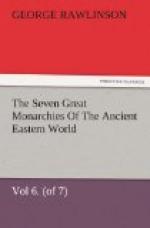[Illustration: PLATE 8.]
A set of reliefs, discovered by the Baron de Bode in the year 1841, are also thought by the best judges to be Parthian. The most important of them represents a personage of consequence, apparently a Magus, who seems to be in the act of consecrating a sacred cippus, round which have been placed wreaths or chaplets. (PLATE IX.) Fifteen spectators are present, arranged in two rows, one above the other, all except the first of them standing. The first sits upon a rude chair or stool. The figures generally are in an advanced stage of decay; but that of the Magus is tolerably well preserved, and probably indicates with sufficient accuracy the costume and appearance of the great hierarchs under the Parthians, The conical cap described by Strabo is very conspicuous. Below this the hair is worn in the puffed-out fashion of the later Parthian period. The upper lip is ornamented by moustaches, and the chin covered by a straight beard. The figure is dressed in a long sleeved tunic, over which is worn a cloak, fastened at the neck by a round brooch, and descending a little below the knees. The legs are encased in a longer and shorter pair of trowsers, the former plain, the latter striped perpendicularly. Round the neck is worn a collar or necklace; and on the right arm are three armlets and three bracelets. The conical cap appears to be striped or fluted.
[Illustration: PLATE 9.]
On the same rock, but in no very evident connection with the main representation, is a second relief, in which a Parthian cavalier, armed with a bow and arrows, and a spear, contends with a wild animal, seemingly a bear. [PLATE X. Fig. 1.] A long flowing robe here takes the place of the more ordinary tunic and trowsers. On the head is worn a rounded cap or tiara. The hair has the usual puffed-out appearance. The bow is carried in the left hand, and the quiver hangs from, the saddle behind the rider, while with his right hand he thrusts his spear into the beast’s neck. The execution of the whole tablet seems to have been rude; but it has suffered so much from time and weather, that no very decided judgment can be passed upon it.
[Illustration: PLATE 10.]
Another still ruder representation occurs also on another face of the same rock. This consists of a female figure reclining upon a couch, and guarded by three male attendants, one at the head of the couch unarmed, and the remaining two at its foot, seated, and armed with spears. The female has puffed-out hair, and carries in her right hand, which is outstretched, a wreath or chaplet. One of the spearmen has a curious rayed head-dress; and the other has a short streamer attached to the head of his spear. Below the main tablet are three rudely carved standing figures, representing probably other attendants.
This set of reliefs may perhaps be best regarded as forming a single series, the Parthian king being represented as engaged in hunting the bear, while the queen awaits his return upon her couch, and the chief Magus attached to the court makes prayer for the monarch’s safety.




